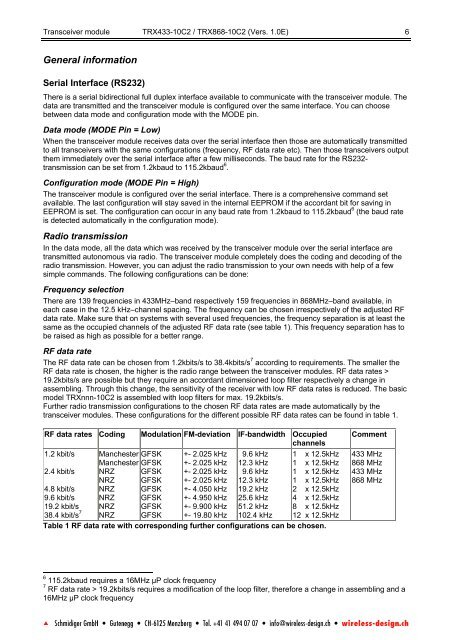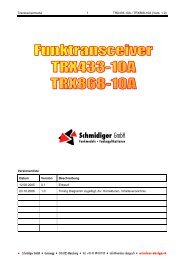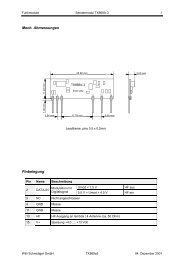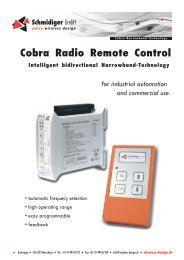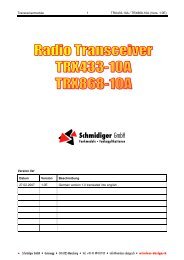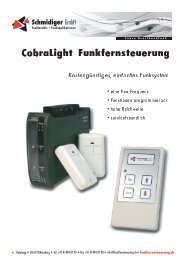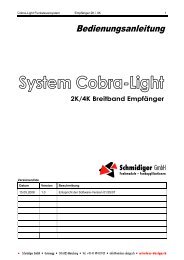Version List
Version List
Version List
Create successful ePaper yourself
Turn your PDF publications into a flip-book with our unique Google optimized e-Paper software.
Transceiver module TRX433-10C2 / TRX868-10C2 (Vers. 1.0E) 6<br />
General information<br />
Serial Interface (RS232)<br />
There is a serial bidirectional full duplex interface available to communicate with the transceiver module. The<br />
data are transmitted and the transceiver module is configured over the same interface. You can choose<br />
between data mode and configuration mode with the MODE pin.<br />
Data mode (MODE Pin = Low)<br />
When the transceiver module receives data over the serial interface then those are automatically transmitted<br />
to all transceivers with the same configurations (frequency, RF data rate etc). Then those transceivers output<br />
them immediately over the serial interface after a few milliseconds. The baud rate for the RS232transmission<br />
can be set from 1.2kbaud to 115.2kbaud 6 .<br />
Configuration mode (MODE Pin = High)<br />
The transceiver module is configured over the serial interface. There is a comprehensive command set<br />
available. The last configuration will stay saved in the internal EEPROM if the accordant bit for saving in<br />
EEPROM is set. The configuration can occur in any baud rate from 1.2kbaud to 115.2kbaud 6 (the baud rate<br />
is detected automatically in the configuration mode).<br />
Radio transmission<br />
In the data mode, all the data which was received by the transceiver module over the serial interface are<br />
transmitted autonomous via radio. The transceiver module completely does the coding and decoding of the<br />
radio transmission. However, you can adjust the radio transmission to your own needs with help of a few<br />
simple commands. The following configurations can be done:<br />
Frequency selection<br />
There are 139 frequencies in 433MHz–band respectively 159 frequencies in 868MHz–band available, in<br />
each case in the 12.5 kHz–channel spacing. The frequency can be chosen irrespectively of the adjusted RF<br />
data rate. Make sure that on systems with several used frequencies, the frequency separation is at least the<br />
same as the occupied channels of the adjusted RF data rate (see table 1). This frequency separation has to<br />
be raised as high as possible for a better range.<br />
RF data rate<br />
The RF data rate can be chosen from 1.2kbits/s to 38.4kbits/s 7 according to requirements. The smaller the<br />
RF data rate is chosen, the higher is the radio range between the transceiver modules. RF data rates ><br />
19.2kbits/s are possible but they require an accordant dimensioned loop filter respectively a change in<br />
assembling. Through this change, the sensitivity of the receiver with low RF data rates is reduced. The basic<br />
model TRXnnn-10C2 is assembled with loop filters for max. 19.2kbits/s.<br />
Further radio transmission configurations to the chosen RF data rates are made automatically by the<br />
transceiver modules. These configurations for the different possible RF data rates can be found in table 1.<br />
RF data rates Coding Modulation FM-deviation IF-bandwidth Occupied<br />
channels<br />
1.2 kbit/s<br />
2.4 kbit/s<br />
4.8 kbit/s<br />
9.6 kbit/s<br />
19.2 kbit/s<br />
38.4 kbit/s 7<br />
Manchester GFSK<br />
Manchester GFSK<br />
NRZ GFSK<br />
NRZ GFSK<br />
NRZ GFSK<br />
NRZ GFSK<br />
NRZ GFSK<br />
NRZ GFSK<br />
+- 2.025 kHz<br />
+- 2.025 kHz<br />
+- 2.025 kHz<br />
+- 2.025 kHz<br />
+- 4.050 kHz<br />
+- 4.950 kHz<br />
+- 9.900 kHz<br />
+- 19.80 kHz<br />
9.6 kHz<br />
12.3 kHz<br />
9.6 kHz<br />
12.3 kHz<br />
19.2 kHz<br />
25.6 kHz<br />
51.2 kHz<br />
102.4 kHz<br />
1 x 12.5kHz<br />
1 x 12.5kHz<br />
1 x 12.5kHz<br />
1 x 12.5kHz<br />
2 x 12.5kHz<br />
4 x 12.5kHz<br />
8 x 12.5kHz<br />
12 x 12.5kHz<br />
Table 1 RF data rate with corresponding further configurations can be chosen.<br />
Comment<br />
433 MHz<br />
868 MHz<br />
433 MHz<br />
868 MHz<br />
6<br />
115.2kbaud requires a 16MHz µP clock frequency<br />
7<br />
RF data rate > 19.2kbits/s requires a modification of the loop filter, therefore a change in assembling and a<br />
16MHz µP clock frequency


